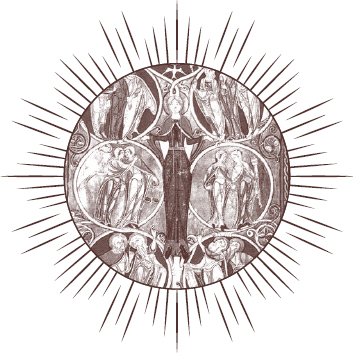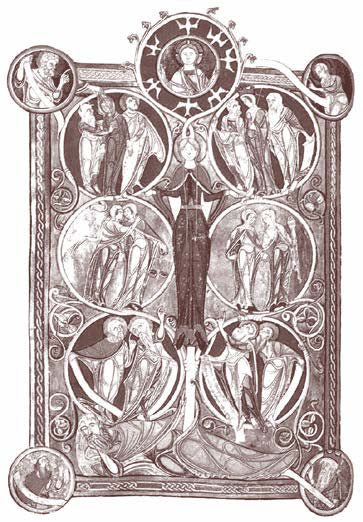

![]()
An excellent option to warm the frosty nights of Advent is German mulled wine. Known as “glow wine” because of the hot irons once used to make it, Glühwein, or Glüwein, is traditionally consumed during the winter around Christmas, although it is also associated with the season of Advent. Here is a simple recipe for one person, followed by another for two to four.
![]()
Glühwein (Individual)
4 oz. claret (or any hearty, dry red wine)
1 stick cinnamon
½ tsp. sugar
1 orange peel
1 lemon peel
1 whole clove
![]()
Build in a small saucepan, bring to the boiling point, let cool a little, and serve in Irish coffee cups or coffee mugs.
Note: Do not allow the mix to boil, or the alcohol will evaporate—unless, of course, you are serving children and want it to evaporate.

![]()
Glühwein (Serves Two to Four)
1 bottle of claret or any hearty, dry red wine
3 sticks cinnamon
3 tbsp. sugar
1 orange, sliced
1 lemon, sliced
3 whole cloves
cardamom or ginger, to taste
![]()
Build in a saucepan, bring to the boiling point, let cool a little, and serve in Irish coffee cups or coffee mugs.
Note: Do not allow the mix to boil, or the alcohol will evaporate—unless, of course, you are serving children and want it to evaporate.

![]()
ADVENT SUNDAY, OR FIRST SUNDAY OF ADVENT
![]()
The beginning of the liturgical year is also called Stir-Up Sunday because the collect in the traditional Missal begins with the words, “Stir up, we beseech Thee.” Stir-Up Sunday also became the occasion for stirring up Christmas pudding in preparation for the great holiday. It even inspired a little ditty:
The pudding in the pot;
And when we get home
We’ll eat the lot.
You may have noticed in this book that we have not weighed in on the battle raging among mixologists and imbibers about shaking versus stirring. Our neutrality on this issue is inspired by the famous Catholic principle “In necessary things, unity; in doubtful things, liberty; in all things, charity.” But today let us give the nod to the stirring faction. Whatever cocktail you have tonight, let it be stirred, not shaken.
And if you are following the 1962 Missal, or if the readings in the new Missal have as the Gospel this year Matthew 24:36–44, turn to the drinks from the Last Sunday after Pentecost (pp. 425–27).
GAUDETE SUNDAY, OR THIRD SUNDAY OF ADVENT
![]()
Most folks remember this Sunday in Advent as the one where the priest wears “pink” vestments. Just don’t say that to the priest or he’ll never wear them again (priests are men too, after all). The technical name for this beautiful liturgical hue is rose. Symbolically, rose can be seen as a lighter shade of the penitential color of violet, and thus it still evokes the penitence of the season but with an added dimension of joyful anticipation. The name Gaudete (“Rejoice”) comes from the opening word of the traditional introit (entrance antiphon) and the theme of the epistle. It expresses the jubilance of waiting with hopeful certainty in the Lord’s fulfillment of His promises. On this Sunday there is a slight relaxation of the rigors of Advent, a sort of catching of one’s breath before the final penitential push.
And Drinking with the Saints is all about exploiting such relaxations. Catch your breath tonight with a pink or rose-colored cocktail. Have recourse to your favorite one, or try one of the three we hereby recommend. Let’s start with the classic Pink Gin, made famous by Great Britain’s Royal Navy in the nineteenth century. In 1824 it was discovered that bitters could cure seasickness. To encourage sailors to drink bitters, the navy served it with something it knew its seamen would like—gin. Or to be more specific, it mixed bitters, which gives the drink its pink color, with “sweet” Plymouth gin instead of “dry” London gin.
![]()
Pink Gin
1½ oz. Plymouth gin, chilled
1 dash Angostura bitters
1 lemon twist
![]()
Take a chilled cocktail glass, add the bitters, and coat the interior of the glass with the bitters by swirling it around. Add gin and garnish with lemon twist.
You can also dazzle your friends with your knowledge by asking them if they “want it in or out”—that is, if they want the remaining bitters tossed out after it has coated the glass or left in.

![]()
If you have only dry London gin on hand, try a Pink Rose.
![]()
Pink Rose
1½ oz. gin
¼ oz. grenadine
¼ oz. cream
1 egg white
¼ oz. lemon juice
![]()
Pour all ingredients into a shaker filled with ice and shake forty times. Strain into a cocktail glass.

![]()
Or try this lovely and refreshing libation that we discovered in a 1934 cocktail manual. It is called a Bacardi Cocktail, but in our household we refer to it as a Jubilee.
![]()
Bacardi Cocktail
2 oz. Bacardi rum
½ oz. grenadine
½ oz. lemon juice
![]()
Pour all ingredients into a shaker filled with ice and shake forty times. Strain into a cocktail glass.

![]()
![]()
DECEMBER 17–23
If you have ever wondered about the inspiration behind the beloved Advent hymn “O Come, O Come, Emmanuel,” wonder no more. The answer is the Great Antiphons, also called the O Antiphons. Beginning on December 17 and ending on the evening of December 23, the Church uses seven special antiphons for its office of Vespers that call upon Jesus Christ under a different title: “O Wisdom,” “O Adonai,” “O Root of Jesse,” “O Key of David,” “O Dawn,” “O King of the Gentiles,” and “O Emmanuel.” Together these titles retrace the influence of the Son of God on sacred history even before He became Incarnate.
The antiphons are also noteworthy for their “secret code.” Take the first letter of these Latin titles from each antiphon (Sapientia, Adonai, Radix, Clavis, Oriens, Rex, Emmanuel), and you will see that they form an acrostic that, when read backward, spells ERO CRAS—Latin for “I will be [there] tomorrow!” It is as if Christ were answering our prayers through the very prayers themselves.

Liquid Treats
The period of the O Antiphons, sometimes called Sapientiatide, is a time of heightened anticipation for the Lord’s coming and a period of irrepressible joy. It was so distinctive that the admonition “Keep your O” was common parlance in several medieval monasteries. This salutation always makes us chuckle, perhaps because we imagine it being voiced in an ultra-cool, Barry White bass.
In the medieval cloister, Sapientiatide was often marked by little treats. According to Maria von Trapp, on the day when Christ is called the “Root of Jesse,” Brother Gardener would bring out “his choicest vegetables and fruits, with specially beautiful roots among them.” Or on the day when Christ is invoked as the “Key of David,” Brother Cellarer “used his key for the wine cellar and brought out the best wine.” On the final day, the abbot gave special gifts to all the brothers.
Exercising your imagination, come up with brewed, fermented, or distilled tributes to the various titles of Our Lord in the O Antiphons. For instance, a fiery whiskey might work for Adonai, who appeared in the burning bush (December 18), while a liquor made from an herb or root could hit the spot for the “Root of Jesse” (or a cocktail involving ginger beer or ginger ale?). See the Last Call for the complete set of antiphons.
Holy Wine
The monks in the monastery of San Benedetto in Norcia, Italy, keep a lovely, simplified version of the treat tradition. “Although our fast continues throughout Advent,” they state, “in the O-antiphon week, following an ancient monastic tradition, we have a special glass of Vinsanto each night after Vespers, heightening even more the sense of joy to come. The Church and Refectory combined help us to live the truth of our Faith in body and spirit.”
In imitation of the monks of Norcia, have a little Vin Santo (also called Vinsanto or Vino Santo), a generic kind of Italian dessert wine linked most closely to the region of Tuscany. Vin Santos are usually white and can range from dry to extremely sweet. Vino Santo, or “Holy Wine,” is so called either because it was the wine used for the Mass (sweet white wine being the dominant preference) or because fermentation traditionally began around All Saints’ Day and bottling during Easter Week. Surely the wine is holy, for a cross is typically found on the casks used for aging.
There are dozens of Italian wineries that make Vinsanto, and some bottlings can run into the hundreds of dollars. Among the most affordable yet delicious options exported to the United States are Villa di Campobello’s Il Santo, Villa Puccini’s Santo Vino, and Badia a Coltibuono’s Vin Santo del Chianti Classico.
Whatever your choice, be sure to recite the antiphon of the day. Or, once the effects of the treat have set in, sing “O Come, O Come, Emmanuel.”
December 17:
O Wisdom that came forth from the mouth of the Most High, reaching from one end to another and ordering all things mightily and sweetly: come to teach us the way of prudence.
December 18:
O Adonai, and Ruler of the house of Israel, Who appeared unto Moses in the burning bush and gave him the law on Sinai: come to redeem us with an outstretched arm.
December 19:
O Root of Jesse, which standest for an ensign of the people, before whom the kings shall shut their mouths and the Gentiles shall pray: come to deliver us, and tarry not already!
December 20:
O Key of David, and Scepter of the house of Israel, Thou that openest and no man shutteth, Thou that shuttest and no man openeth: come and liberate the prisoner from prison, sitting in darkness and in the shadow of death.
December 21:
O Dayspring, Brightness of the everlasting light and Son of justice: come and shine on them that sit in darkness and in the shadow of death.
December 22:
O King of the Gentiles, and the Desire thereof! O Cornerstone, that makest two into one: come and save mankind, whom Thou hast made from the slime of the earth.
December 23:
O Emmanuel, our King and our Law-Giver, Longing of the Gentiles, and Savior thereof: come to save us, O Lord our God.
And remember: Keep your O, baby.